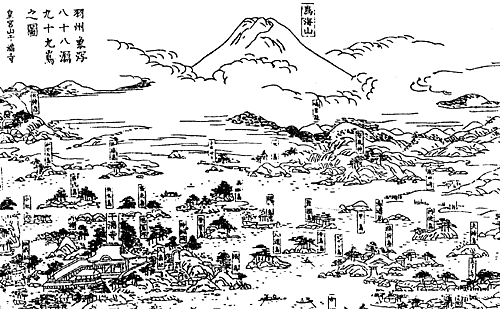On August 1, 1689, Basho visited Kisakata (象潟), Akita Prefecture (秋田県), Northern Honshu, on his journey.
Basho wrote about Kisakata in his travel diary The Narrow Road to Oku, 『おくのほそ道 (Oku no Hosomichi 』 .
Here I take up the latter part of this section.
此寺の方丈に座して簾を捲ば、風景一眼の中に尽て、南に鳥海、天をさヽえ、其陰うつりて江にあり、西はむやむやの関、路をかぎり、東に堤を築て、秋田にかよふ道遥に、海北にかまえて、浪打入る所を汐こしと云。江の縦横一里ばかり、俤松島にかよひて、又異なり。松島は笑ふが如く、象潟はうらむがごとし。寂しさに悲しみをくはえて、地勢魂をなやますに似たり。
Here is a painting of Kisakata exhibited at the Kanmanji Temple.
Photo courtesy; as per original copyright at:
http://staff.aist.go.jp/nakano.shun/Jap/Chokai/news/recently.html
Donald Keene translated this part into English as follows:
Seated within the priests’ quarters of the temple, I rolled up the bamboo blinds and took in all at once the whole spectacle of Kisakata. To the south loomed Mount Chokai, supporting the heavens; its image was reflected in the water. To the west, one can see as far as Muyamuya Barrier; to the east, the road over the embankment leads to Akita in the distance. The sea is to the north. The place where the waves of the sea break into the lagoon is called Tide-Crossing. Kisakata is about two miles in either direction.
Kisakata resembles Matsushima, but there is a difference. Matsushima seems to be smiling, but Kisakata wears a look of grief. There is a sadness mingled with the silent calm, a configuration to trouble the soul.
Basho’s last lines say that there is something woeful about Kisakata.
I wonder if Basho predicted that such a natural disaster as earthquake might occur in Kisakata in the future.
In fact, on July 10, 1804, a big earthquake occurred in Kisakata about 115 years after Basho’s visit there. The earthquake caused upheaval of ground by 2.4 meters. As a result, the lagoons were changed into dry land.
Here is a photo of the backyard of the Kanmanji Temple in Kisakata, 321 years after Basho’s visit.
Koji Otomo, curator at Shoji Taro Memorial Museum in Akita-city, contributed his poems on the earth to our network.
春愁 無情 Spring Woe No Mercy
東海林太郎音楽館館長 大友康二
大地 ゆらぐ日 On the day when the earth quakes
海 怒りて the sea gets furious
慟哭 cries bitterly
三陸の海を the Sanriku coast
引き裂く tears into pieces
花 待つことなく Flowers wait for no man
人 逝く those there pass away
波に 消える vanish into waves
あわれ alas!
世界に ただひとつ The only nation in the world
被爆の国 ニッポン the atom-bombed nation, Japan
その空に in the skies
白い光の 恐怖 the terrors of white rays
六十有余年 A little more than 60 years
問われる 政治 what has politics done?
問われる いのち what is life?
喪われた こころ lost hearts
なぜ Why?
どうして for what reason?
繰り返すことばは the repeated words
がれきに 吸い込まれ are absorbed into rubbles
沈黙(しじま) 空しく silence is empty
潰滅の地に In the annihilated areas
おののきばかり there remain nothing but shivers
人 ただ侘(た)つ those there have only to mourn
ふるさとの こころに In the heart of home
槌音 響くは hammering sounds will resound
いつの日か when is it?
Here is a photo of the ruined fortress (払田柵)in Akita Prefecture(秋田県), constructed in the Heian period(平安時代)(794-1185).
Haikuists in Akita contributed haiku to our network.
They are members of the haiku group: Ten’I (Providence)(天為俳句会)led by Dr. Akito Arima(主宰 有馬朗人).
余震なほ朔太郎忌の星月夜 伊藤沐雨 (Mokuu Ito)
aftershocks come
on the starlit night
Sakutaro’s anniversary
燭台に朱のろうそくや余震来る 伊藤智子 (Satoko Ito)
on the candlestick
vermeil candles burning
the aftershock comes
大津波退きオリオンの煌めける 伊藤慶子 (Keiko Ito)
huge tsunami gone out
Orion’s Belt
sparkling
大地震の果てなる春の浅きかな 五十嵐義知 (Yoshitomo Igarashi)
great earthquake over
this spring
how transient!
なにもかも攫はれし地に黄水仙 笹尾巳生子 (Mioko Sasao)
everything lost
in the waste land
jonquils bloom
鎮魂の瓦礫の町に春の雪 進藤八重子 (Yaeko Shindo)
consoling
the towns of devastation
spring snow
奥入瀬の激しき調べ春の霜 鈴木東亜子 (Toako Suzuki)
intense music
of the Oirase River
spring frost
浴槽の揺れの余震や春寒 寺田恵子 (Keiko Terata)
the aftershock
of bathtub shaking
spring cold
被災地につくしたんぽぽなずなかな 山内誠子 (Seiko Yamanouchi)
for the devastated areas ―
field horsetail’s shoots,
dandelions, and shepherd’s purses
囀に小さな森の膨らめり 和田仁 (Jin Wada)
birdsongs resounding
the small woods seem
bigger and bigger
Here is a photo of daffodils and local springwater (郷清水) in Akita Prefecture.
Hiroko Kawashiri (川尻弘子) in Akita contributed haiku too.
地震止みて運河に重き春の雪
the earthquake over
too heavy for the canal
spring snow
誰からか呼ばれたやうな朧月
the pale moon ―
i feel like…
someone is calling
Last of all, let me post my haiku.
草青む払田柵やよみがえる
grasses growing
over the ruined fortress
reconstructing
The next posting ‘Haiku about the Great East Japan Earthquake (5)’ appears on May 28.
― Hidenori Hiruta




The Naso no Shirataki waterfall in.Kisakata..Kisakata -machi was a located in ..On along with the town of Kisakata was merged into the city of ..In the.town had an estimated of 12 836 and a of 103.50 persons per . The total area was 124.02 km ..The poet visited Kisakata as part of his travels in. There is a.statue of Bash at the Kanman Temple which he visited..For hikers and climbers Kisakata is the jumping-off point for trips to Mount.Ch kai.